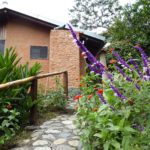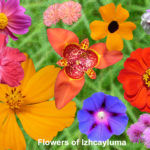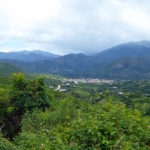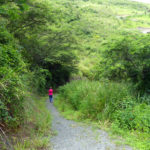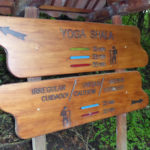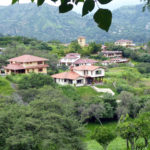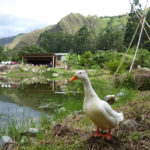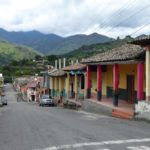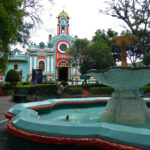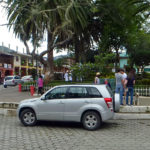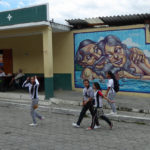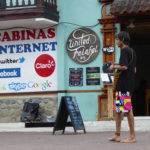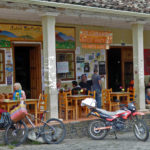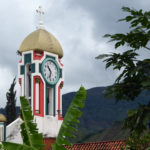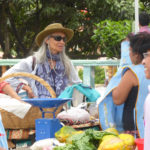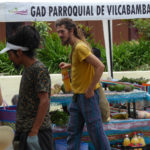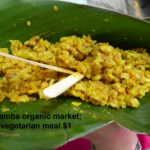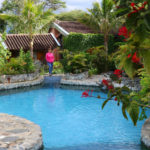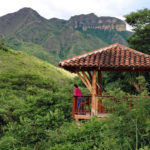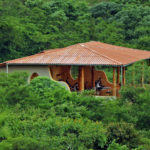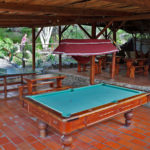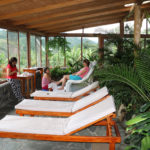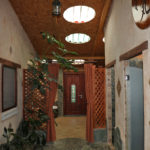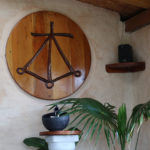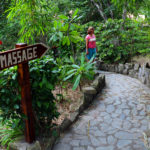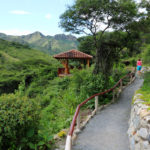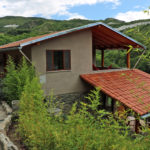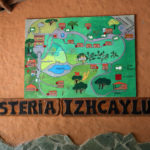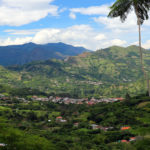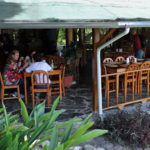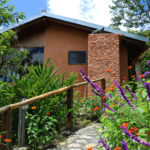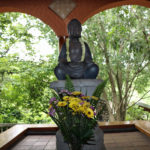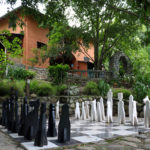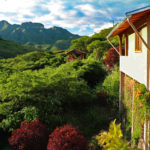A growing number of travelers from around the world have begun an exodus to a tiny town in southern Ecuador—Vilcabamba—that sits tucked away in a green valley surrounded by a series of undulating mountains. Some, like my wife and myself, are drawn to its scenic beauty and mild weather for a brief getaway, while others have decided to move there permanently to escape from a variety of perceived ills in our Western civilization.
Around a thousand mostly long-haired foreigners mix peaceably with the four thousand locals, many of whom claim to live so long that the area has been called the “Valley of Longevity.” The area’s appeal even extended to the Inca royalty who used to vacation there. Appropriately, a mountain called Mandango or “the Sleeping Inca” overlooks the town and is said to protect the area from earthquakes and other natural disasters. After our month-long stay in the Ecuadorian expat retirement-haven of Cuenca (see my article at http://tinyurl.com/julnbfx), my wife and I felt compelled to explore the mystery and the magic of Vilcabamba, and one of its lodges with the unpronounceable name, Hosteria Izhcayluma (“eesh – kuh – looma”), that fellow-travelers had consistently raved about.
Our four-hour, 110-mile drive through the mountains of Ecuador was a memorable, and sometimes startling, experience as we dodged rocks in the road from small landslides and passed slow trucks on blind curves. The two-lane road led us through an endless series of mountains whose vertiginous slopes were covered with bright green cow pastures extending from the highest and steepest peaks to the valley floors below. Rectangular cornfields completed the centuries-old agricultural mosaic and, although I understood the need for the poor farmers to earn their living, I deeply regretted the substantial loss of the once-dense original forests.
Fortunately, the clever owners of Hosteria Izhcayluma had made it easy for us to get directly from Cuenca to their lodge via their inexpensive ($15 per person) daily shuttle service, but because we passed through Vilcabamba very late in the day, we had to wait til the next morning to discover the town. This lodge far exceeded our expectations, and was the key to our visit’s success—but more on that later….
Exploring Vilcabamba on a Saturday morning, we came across the weekly organic market where mostly expat farmers come to sell their produce and homemade concoctions. This gave me an opportunity to talk with a longtime American resident about the foreign community there: “Why do people frequently describe Vilcabamba as a lovely place but full of hippies?” Her response: “Well, I’m not sure I would use the term hippies, but most people here are committed to an alternative lifestyle. Probably 80% of the expats here believe in some sort of conspiracy theory. I know for a fact that chemtrails are being used by governments and corporations to control us, so that’s one of the reasons I moved here, along with escaping the conservative U.S. government at that time.”
We found Vilcabamba to be a fairly clean, graffiti-free and tranquil town, with only two stoplights, very little traffic, and no building above 3 stories tall. The small, pleasantly landscaped plaza in the middle of town provides the focal point for eating, meeting, shopping or praying. Surrounding the plaza is a variety of small shops, expat-friendly restaurants (like the Vegetable Bar and the Falafel Café (?) ) and a Catholic church whose curvilinear façade is cheerfully painted in a variety of colors. Kids played in the park’s fountain or kicked around a soccer ball while local folks sat or strolled alongside the ubiquitous foreigners, many of whom were young and generally long-haired, barefoot, and carrying a backpack. Older expats frequented one or two of the combo bar/restaurants nearby, nursing a cold beer while chatting together. Although we were clearly in a different sort of place, the general “vibe” was so soothingly relaxed that the town’s motto should be, “you do your thing and I’ll do mine.”
We heard that on Sunday afternoon a music festival was being held at a nearby commune called Chambalabamba, and upon hearing that visitors were welcome, we couldn’t resist the urge to explore this example of alternative living (the name alone compelled me to visit). Upon our arrival, the owner, a middle-aged refugee from New Jersey and a self-proclaimed anarchist who changed his name to Mafufu because he liked the sound of it, graciously showed us around his community. Some residents lived in teepees and others in mud homes, while Mafufu’s home was an impressively large, well-constructed tree house, complete with a hanging bridge leading to a bathroom with a view from his bathtub of a stream cascading below. Back by the main stage, various musicians entertained our avant garde group as kids nursed or ran barefoot and carefree around the nearby pond. We sat on the grass, eating a slice of home-made pizza and observing how these people were living their lives, by all appearances happily, far removed from modern amenities and accompanying stress.
But what truly made our Vilcabamba visit special was Hosteria Izhcayluma. Perched on a hillside 2km from town, Izhcayluma seemed more like the Shangri-la of southern Ecuador than a mere hotel. We never tired of the open-air restaurant’s postcard-perfect view of the town below and the surrounding mountains. As soon as we entered the reception area and saw that view, and our resort’s myriad flowers and trees, swimming pool, massage center, yoga retreat, bar/entertainment lounge and well-spaced cottages with hammocks by each one, we knew that we had arrived in a magic place. Several visitors we had met previously said that they had regretting only staying two or three nights, so we booked our cottage for six nights and we were glad we did.
The restaurant served a full menu of reasonably priced, well-prepared meals which we ate on the veranda, but the real treat was reserved for the afternoons when we would walk over to the massage spa for our 75-minute full body massage (for $22). With such reasonable prices, my wife splurged on more massages, a facial and pedicure, too.
Each morning at 7am, we started our day with the free yoga class held in the attractive, open-air yoga studio situated across from the cabins on a hillside. During the class, my mantra was that I must never forget that amazing scene–laying on my yoga mat listening to birds singing, feeling the coolness of the morning breeze stroking my face and watching the sun’s rays slowly illuminate the face of the imposing distant mountain, Mandango, watching over us. The vibe in Vilcabamba was tranquil, but at Izhcayluma it was pure delight. We will be back.
Doug Hansen is a travel writer and photographer in Carlsbad, CA. See more photos and articles at www.HansenTravel.org or Instagram @doug6636.
…………………………………………………………………………………………………………………………………………
IF YOU GO:
LODGING: Hostal Izhcayluma, address: E682, Vilcabamba, Ecuador; phone: +593 7-264-0095; http://www.izhcayluma.com; email: Hostería Izhcayluma izhcayluma@yahoo.de.
CURRENCY: US coins and bills are exclusively used in Ecuador.
ELECTRICITY: 110 – 120v, same as in the US, with same plugs (but bring a 3 prong to 2 prong adapter just in case).
WHEN TO GO: Vilcabamba has a subtropical climate whose temperature varies little throughout the year The drier season runs from May through September and the wetter season extends from October to April (see weather averages at http://tinyurl.com/zof4fgr.)
MISC: Bring good hiking shoes (depending on where you go, trails are often rough or muddy), swimsuit, sunscreen, insect repellent, hat, rain jacket or umbrella; the key for Ecuador is dress in layers to accommodate varying weather conditions at any time.


